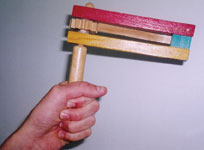 One of the most popular customs for Purim is to drown out the name of the villain, Haman, with a noisemaker. In Hebrew, the noisemaker is called a ra’ashan; in Yiddish, it is a gragger.
One of the most popular customs for Purim is to drown out the name of the villain, Haman, with a noisemaker. In Hebrew, the noisemaker is called a ra’ashan; in Yiddish, it is a gragger.
The origin of this custom comes from the Book of Exodus 17:4: “For I will utterly blot out the remembrance of Amalek from under the Heavens.” Haman’s ancestors were Amalekites.
Around the 9th century, it was customary for European Jews to take flat stones or wooden paddles on which Haman’s name was inscribed and beat them together when Haman’s name was mentioned, in the reading of the Megillat Ester. It was also popular to write Haman’s name on the soles of their shoes and then stamp their feet when his name was read, thus erasing his name.
Some form of gragger has been used since the Middle Ages, primarily among Ashkenazic Jews. Today, the traditional gragger looks like the Hebrew letter dalet, a horizontal piece made of wood or metal with a rotating cylinder or tongue attached to a vertical handle, which, when turned, makes noise.
The custom of using a noisemaker during the reading of the Megillah is more recent among Sephardic Jews.
One also finds graggers decorated with illustrations from the Book of Esther, plastic with clapping hands, and designs in wood and metal. School children often make other containers of paper or metal and fill them with beans, so when they are shaken, they make noise. In Kansas City, some congregation are using boxes of macaroni and cheese as noisemakers and then donating them to food pantries.
Whatever gragger you use for Purim, just make sure you do it loud and often, for in each generation, a Haman has arisen to live among us!


